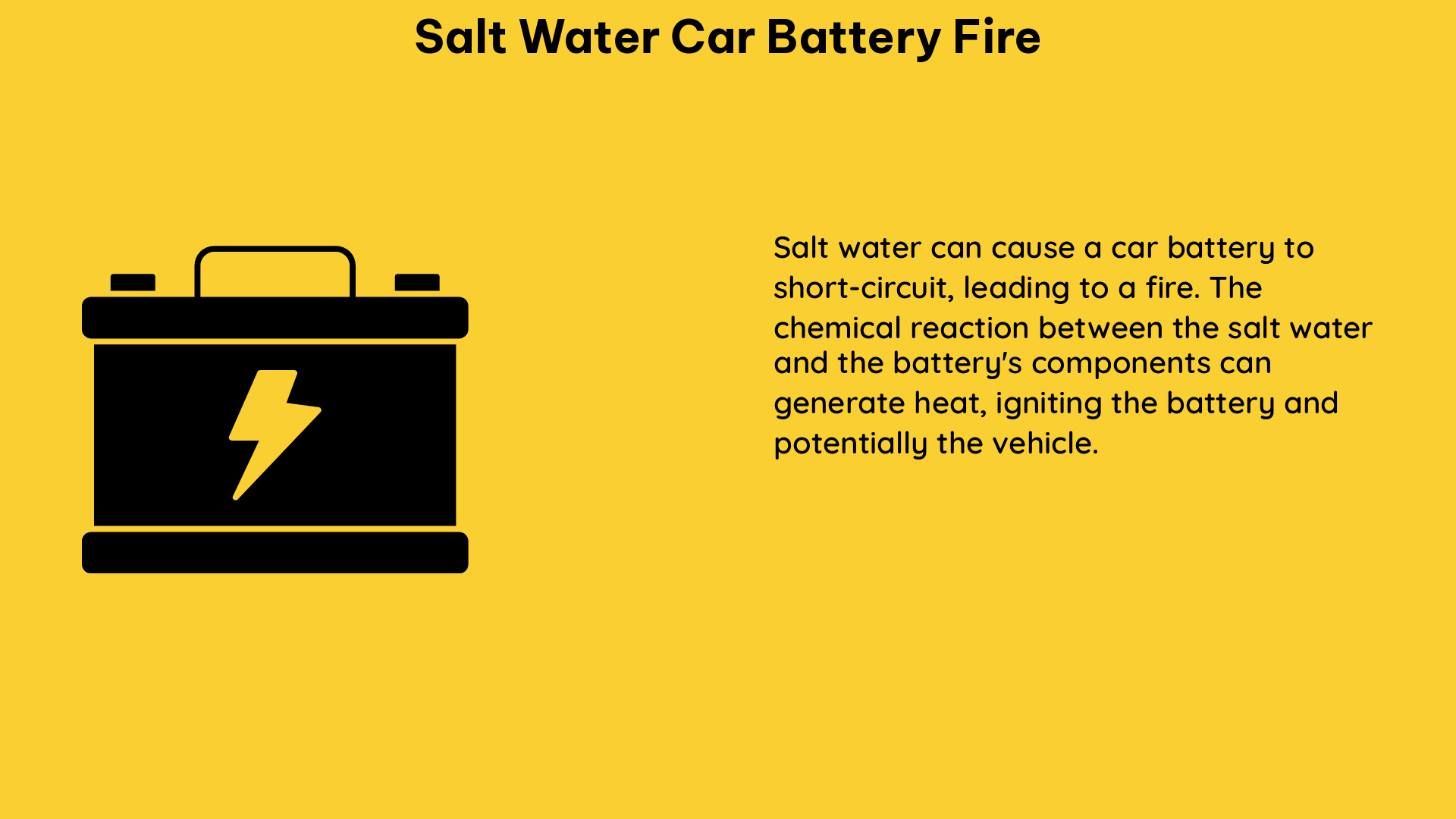As electric vehicles (EVs) continue to gain popularity, the risks associated with saltwater exposure to their batteries have become a growing concern, especially in coastal regions. Saltwater intrusion can significantly degrade lithium-ion (Li-ion) batteries, leading to a heightened risk of chemical reactions and potentially catastrophic fires. This comprehensive guide delves into the technical details, potential solutions, and practical steps to mitigate the dangers of saltwater car battery fires.
Understanding the Threat of Saltwater Exposure
Saltwater exposure can have a devastating impact on the performance and safety of Li-ion batteries used in electric vehicles. The high concentration of dissolved salts in seawater can penetrate the battery’s internal components, leading to a series of chemical reactions that can ultimately result in a fire.
Saltwater Degradation of Li-ion Batteries
- Saltwater can corrode the battery’s metal components, including the anode, cathode, and current collectors, causing a breakdown of the battery’s internal structure.
- The dissolved salts can also interfere with the battery’s electrolyte, disrupting the delicate balance of ions necessary for efficient charge and discharge cycles.
- This degradation can lead to the formation of harmful metallic structures called dendrites on the negative electrode, which can puncture the separator and cause short circuits.
Increased Fire Risk
- The chemical reactions triggered by saltwater exposure can generate significant heat, pressure, and the release of flammable gases within the battery.
- This volatile combination creates an extreme fire risk, as the battery can rapidly overheat and ignite, potentially leading to a catastrophic event.
- In Lee County, Florida, it is estimated that over 7,000 electric vehicles are at risk of saltwater-related damage and the associated fire hazard.
Innovative Solutions: Aqueous Batteries with Saltwater Electrolytes

To address the challenges posed by saltwater exposure, researchers at the University of Central Florida (UCF) have developed a groundbreaking solution: aqueous batteries that use saltwater as the electrolyte.
Eliminating Volatile Solvents
- Conventional Li-ion batteries rely on highly volatile organic solvents in their electrolytes, which can contribute to the fire risk.
- The UCF researchers’ aqueous battery design eliminates these volatile solvents, replacing them with a saltwater-based electrolyte that is inherently safer and less flammable.
Rapid Charging Capabilities
- The aqueous battery developed by the UCF team can reach a full charge in just three minutes, a significant improvement over the hours required for traditional Li-ion batteries.
- This rapid charging capability is enabled by the battery’s novel nano-engineering, which prevents the growth of harmful dendrites on the negative electrode.
Enhanced Stability and Safety
- The aqueous battery’s saltwater electrolyte and advanced nano-engineering contribute to its increased stability and safety, reducing the risk of thermal runaway and fire.
- By preventing the formation of dendrites, the battery’s internal structure remains intact, further enhancing its overall reliability and performance.
Mitigating Saltwater Exposure Risks: Practical Steps for EV Owners
While the development of aqueous batteries with saltwater electrolytes is an exciting advancement, individual EV owners can also take proactive measures to reduce the risks associated with saltwater exposure.
Proper Maintenance and Inspection
- Regularly inspect your electric vehicle for any signs of saltwater intrusion, such as corrosion on the battery pack or other exposed components.
- Ensure that your vehicle’s seals and gaskets are in good condition to prevent saltwater from entering the battery compartment.
- Follow the manufacturer’s recommended maintenance schedule and seek professional assistance if any issues are detected.
Protective Measures
- Consider installing additional protective measures, such as water-resistant underbody coatings or sealants, to shield your EV’s battery pack from saltwater exposure.
- Avoid parking your electric vehicle in areas prone to flooding or saltwater accumulation, such as coastal regions or areas with high tides.
- If your vehicle is exposed to saltwater, promptly clean and rinse the affected areas to minimize the risk of corrosion and battery degradation.
Environmental Considerations
- Existing Li-ion batteries in electric vehicles can release toxic pollutants, including per- and polyfluoroalkyl substances (PFAS), into the environment during a fire.
- These pollutants can have severe consequences for the surrounding ecosystem, contaminating soil, water, and wildlife.
- The use of aqueous batteries with saltwater electrolytes can potentially mitigate the environmental impact of EV battery fires, as they do not contain the same volatile and toxic components.
By understanding the technical details, innovative solutions, and practical steps to address saltwater car battery fires, EV owners can take proactive measures to ensure the safety and reliability of their vehicles, while also contributing to a more sustainable and environmentally-friendly future.
References:
- Marine Safety Alert: Saltwater Intrusion Causes Damage to Electric Vehicle Batteries
- Putting Out Electric Vehicle Fires with Saltwater
- Environmental Impacts of Electric Vehicle Battery Fires: Releases of Metals, Ions, and Per- and Polyfluoroalkyl Substances to Surface Waters
- Aqueous Batteries: A Promising Solution for Electric Vehicles
- Saltwater Exposure and Electric Vehicles: Risks and Mitigation Strategies

The lambdageeks.com Core SME Team is a group of experienced subject matter experts from diverse scientific and technical fields including Physics, Chemistry, Technology,Electronics & Electrical Engineering, Automotive, Mechanical Engineering. Our team collaborates to create high-quality, well-researched articles on a wide range of science and technology topics for the lambdageeks.com website.
All Our Senior SME are having more than 7 Years of experience in the respective fields . They are either Working Industry Professionals or assocaited With different Universities. Refer Our Authors Page to get to know About our Core SMEs.